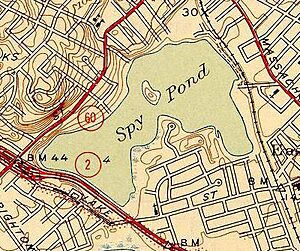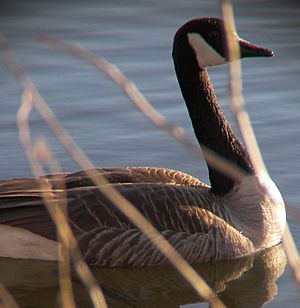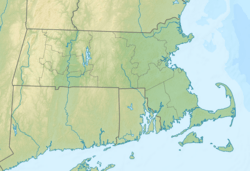Spy Pond facts for kids
Quick facts for kids Spy Pond |
|
|---|---|

Sunset in the winter
|
|
| Location | Arlington, Massachusetts |
| Coordinates | 42°24′28″N 71°09′22″W / 42.40778°N 71.15611°W |
| Type | kettle hole |
| Basin countries | United States |
| Surface area | 103 acres (42 ha) |
| Average depth | 12 ft (3.7 m) |
| Max. depth | 36 ft (11 m) |
Spy Pond is a beautiful pond located in Arlington, Massachusetts. It covers about 103 acres and is known as a kettle hole pond. This means it was formed in a special way by ancient glaciers! You can find it right next to the popular Minuteman Bikeway.
| Top - 0-9 A B C D E F G H I J K L M N O P Q R S T U V W X Y Z |
How Spy Pond Was Formed
A Glacier's Gift
Imagine a giant sheet of ice, a mile thick, covering the area where Spy Pond is today. This was the Wisconsin Glacier, about 50,000 years ago! Around 15,000 years ago, this huge ice sheet started to melt and move back.
As the glacier melted, it left behind big dips or holes in the ground. These are called "kettle holes". Water from the melting ice and later from rain filled these holes, creating small lakes and ponds like Spy Pond.
Water Sources and Depth
Today, Spy Pond gets its water from two main places:
- Groundwater: Water that seeps up from underground.
- Surface runoff: Rainwater that flows over the land into the pond.
The pond is usually about 12 feet (3.7 meters) deep. At its deepest point, it goes down to 36 feet (11 meters)!
Elizabeth Island
Spy Pond has a small island called Elizabeth Island, which is about two acres (0.8 hectares) in size. For a long time, it was privately owned. But in 2010, a group called Arlington Land Trust, working with the Massachusetts Audubon Society, bought the island. They wanted to protect it and keep it as a natural home for animals and plants.
Spy Pond's Past

Revolutionary War Story
On April 19, 1775, during the American Revolutionary War, a brave elderly woman named Mother Batherick was gathering dandelions near Spy Pond. She saw six British soldiers, known as "Redcoats," running away after their supplies were captured. Mother Batherick managed to catch them and take them prisoner!
Water and Ice Business
In 1850, a company started piping water from Spy Pond to a nearby town. This company later changed its name to the Arlington Lake Company.

In the 1800s, Spy Pond became a busy place for businesses. People realized the pond was a great natural resource. In winter, they would cut huge blocks of ice from the frozen pond. This ice was so important that it was shipped all the way to places like India! This ice trade helped the area grow, leading to the building of railroads and factories that made ice tools.
Training and Protection
During the American Civil War, the Union Army used the area near Spy Pond for training at a place called Camp Sheppard.
In the 1970s, a law called the Wetland Protection Act was passed. This law made Spy Pond a "great pond" under Massachusetts law, meaning it's an important public natural area.
Wildlife of Spy Pond

Spy Pond is home to many different kinds of animals, especially birds and fish!
Birds of the Pond
Bird watchers love Spy Pond! They have seen almost 120 different types of birds living in or visiting the pond throughout the year. This includes 32 kinds of swimming birds and 86 kinds of non-swimming birds.
One of the most well-known birds at Spy Pond is the Canada goose. You'll often see them around the pond's shores.
Fish in the Water
For many years, new fish were added to Spy Pond to keep the fish population healthy. While this stopped in the 1990s, the pond still has many types of fish, such as:
- American eel
- Bluegill
- Carp
- Largemouth bass
- White perch
- Yellow perch
- Pumpkinseed
- Black crappie
- White crappie
- Gizzard shad
Some people have also illegally put northern pike into the pond, and some of these fish have grown very large!
The Spy Pond Monster Legend
There's an old legend about Spy Pond that some children in Arlington love to tell. The story says that in 1990, a Komodo Dragon was bought and released onto Elizabeth Island in the middle of the pond. Kids sometimes call this mysterious creature "Lizzie," "The Spy Pond Monster," or "The Seal."
However, there's no real proof that this monster exists. Komodo Dragons live in warm, tropical places and can't survive cold winters. So, it's likely just a fun story!
Images for kids




